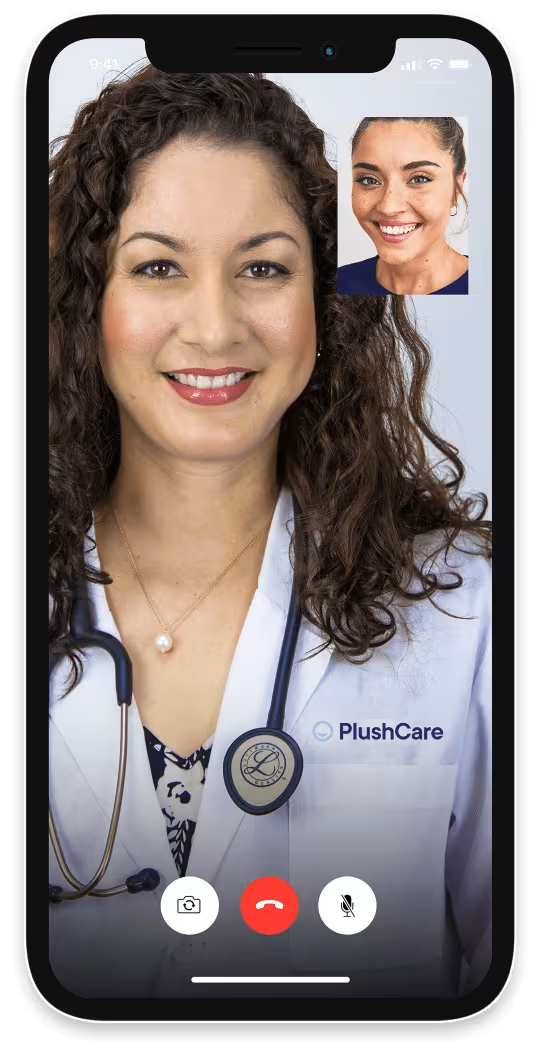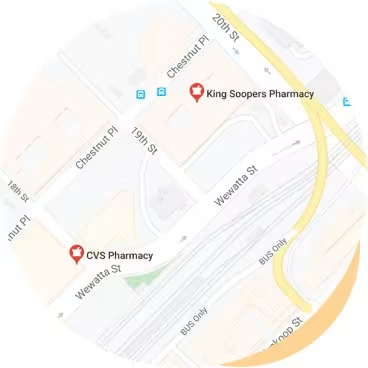- Online Prescriptions
- Chronic Care
- Asthma
Bronchodilator
Bronchodilator prescriptions available online
Learn how bronchodilators can help asthma, chronic obstructive pulmonary disease, and more with a consultation from one of our board-certified doctors online. Get a new prescription or refill for a bronchodilator from a board-certified doctor online.
Book an appointmentOnline same day doctor appointment booking
Available nationwide, with licensed medical providers
Medications available for pharmacy pickup*
*Prescriptions are provided at the doctor’s discretion. Learn more about our controlled substances policy and how you can save up to 80% with our prescription discount card.

About bronchodilators
Bronchodilators, sometimes called rescue inhalers, are medications designed to open up the airways by relaxing the bronchial smooth muscles. Bronchodilator therapy makes it easier for people with asthma or other lung conditions to breathe. They’re often prescribed to help treat asthma and chronic obstructive pulmonary disease (COPD), but they’re used for other conditions as well. There are three types of bronchodilators.
What bronchodilators treat
The most common condition treated with bronchodilators is asthma. Bronchodilators are designed to relax the muscles around your airways and help clear mucus from your lungs. Depending on your symptoms, you may use a long-acting bronchodilator and short-acting bronchodilator for long-term maintenance treatment or quick symptomatic treatment.
Other conditions, such as chronic obstructive pulmonary disease—a lung disease that blocks the airways—are also treated with bronchodilators. COPD patients, including patients with chronic bronchitis and emphysema, may take long-acting forms to make breathing easier and manage COPD symptoms.
Types of bronchodilators available online
The three types of bronchodilator medications are called beta-2 agonists, anticholinergics, and theophyllines.
Beta-2 agonists
Beta-2 agonists are most often used to treat asthma symptoms and COPD. These drugs include short-acting bronchodilators and long-acting bronchodilators. Short-acting forms open the airways to provide quick relief from asthma symptoms, while long-acting forms provide long-term symptom control. You should take long-acting beta-2 agonists with an inhaled corticosteroid to treat asthma.
Examples of beta-2 agonists include:Anticholinergics
Anticholinergic medication is often used to block the effect of acetylcholine, a neurotransmitter that can trigger bronchoconstriction, mucus secretion, and inflammation in people with asthma and COPD. Anticholinergics are available as long-acting bronchodilators.
Examples of anticholinergic drugs include:Theophylline
A theophylline is available as a pill that you take with water. You can take theophylline once daily to help control severe asthma symptoms. However, theophylline is not a preferred treatment method to prevent asthma symptoms.
Examples of theophyllines include:
How bronchodilators work
Bronchodilators work by relaxing the muscles that tighten around your airways (the bronchi). As a result, bronchodilator therapy keeps the airways open, allowing air to move in and out of your lungs. Inhaled bronchodilators can help you breathe more easily and remove mucus from your lungs. In addition, mucus can move more freely, and you can cough mucus up.
Bronchodilator drugs come in two forms: short-acting and long-acting bronchodilators. While short-acting bronchodilators provide quick symptom relief for sudden and severe symptoms, long-acting bronchodilators are used regularly to control the symptoms of asthma and COPD. Bronchodilators may be prescribed in the form of a nebulizer, metered-dose inhaler, or dry powder inhaler.
Side effects of bronchodilators
When taken as prescribed, bronchodilators are generally well tolerated. However, they can still cause some side effects. The more common side effects of bronchodilators include:
Nausea, vomiting, and upset stomach
Rapid heartbeat
Muscle cramps
Nervous or shaky feeling
Dry throat
In rare cases, bronchodilators may cause serious side effects. These can include:Wheezing, choking, or other breathing problems
Worsened breathing problems
Allergic reaction
Little to no urination
Blurred vision or eye pain
Bronchodilator risks
Bronchodilators are generally safe, but there are some risks if you have other medical conditions or take certain medications. Before you take a prescribed bronchodilator, be sure to tell your doctor if you have any of the following conditions or issues:
Overactive thyroid (hyperthyroidism)
Cardiovascular disease, irregular heartbeat, or high blood pressure
Diabetes
Glaucoma
Liver problems, such as liver disease
Stomach ulcers
Epilepsy and other seizure disorders
Bladder outflow obstruction
Bronchodilator drug interactions
When you begin a new medication, make sure to tell your doctor about all the medications, supplements, or herbs you’re taking. Some medications that might interact with a bronchodilator include:
Diuretics (water pills)
Certain antidepressants, including monoamine oxidase inhibitors (MAOIs) and tricyclic antidepressants (TCAs)
Digox (digoxin)
Benzodiazepines
Lithium
Quinolones
PlushCare online bronchodilator ratings and reviews
Our online doctors have treated over 550,000 patients.
Bronchodilator pricing details
How pricing works
To get bronchodilators online, join our monthly membership and get discounted visits.
Paying with insurance
Membership
$16.99/month
First month free
Visits
Copay
30 days of free membership
Same-day appointments 7 days a week
Unlimited messages with your Care Team
Prescription discount card to save up to 80%
Exclusive discounts on lab tests
Free memberships for your family
Cancel anytime
Visit price with insurance
Often the same as an office visit. Most patients with in-network insurance pay $30 or less!
We accept these insurance plans and many more:
Paying without insurance
Membership
$16.99/month
First month free
Visits
$129
30 days of free membership
Same-day appointments 7 days a week
Unlimited messages with your Care Team
Prescription discount card to save up to 80%
Exclusive discounts on lab tests
Free memberships for your family
Cancel anytime
Visit price without insurance
Initial visits are $129.
If we're unable to treat you, we'll provide a full refund.
3 simple steps to getting bronchodilators online

Step 1
Book an appointment to discuss bronchodilators.
Book a same day appointment from anywhere.

Step 2
Talk to your doctor about bronchodilators online.
See a doctor on your smartphone or computer.

Step 3
Pick up your bronchodilator prescription.
We can send bronchodilators to any local pharmacy.
Bronchodilator FAQs
How should I take a bronchodilator?
Always use your bronchodilator medication as prescribed by your healthcare provider. It's important to use your bronchodilator properly to manage your symptoms and get the full medication dosage. Here's how to properly use your bronchodilator:
First, shake the inhaler 10–15 times. Make sure the cap is tightened while you're shaking the medication.
Remove the cap. Then, take a deep breath in and breathe out completely.
Place your mouth around the mouthpiece or face mask, and press the inhaler down one time.
Take a slow, deep breath through your mouth. If you hear a noise, you'll need to slow down your breathing.
Hold your breath for 10 seconds. Be sure to count slowly so your medication can reach your lungs' airways and effectively treat your symptoms.
Repeat these steps for each puff your healthcare professional has recommended. For the best results, you should wait one minute between each puff.
When you're done taking your bronchodilator dose, tighten the cap on your inhaler. If you use inhaled corticosteroids, gargle water when you're finished taking the dose. Rinsing your mouth after using inhaled corticosteroids can help reduce unwanted side effects, such as dry mouth.Who shouldn’t take bronchodilators?
To make sure bronchodilators are safe for you, tell your doctor if you have:
Overactive thyroid (hyperthyroidism, a condition that occurs when there's too much thyroid hormone in the body)
Cardiovascular disease, irregular heartbeat (arrhythmia), high blood pressure, or any other medical conditions that affect the heart or blood vessels
Diabetes or high blood sugar
Glaucoma
Liver problems, such as liver disease
Stomach ulcers
Epilepsy and other seizure disorders
Bladder outflow obstruction or other urination problems
How long does it take for bronchodilators to work?
If you're taking a rescue medication, inhaled bronchodilators will start working minutes after you inhale them to reduce inflammation and other symptoms. Most short-acting bronchodilators work for 4–6 hours.
On the other hand, long-acting bronchodilators require more time to reach their full effect. Long-acting bronchodilators work for approximately 12 hours.What should I avoid with a bronchodilator?
Avoid getting bronchodilator medication in your eyes, especially if you have glaucoma. Make sure to seek medical attention if your breathing problems get worse, or if you think your asthma medicines are not working as well.
It's important to remember that a long-acting bronchodilator medication will not treat an asthma attack or sudden symptoms. Instead, it's best to use a long-acting bronchodilator regularly to manage your symptoms and prevent future attacks.
Don't use bronchodilators more often than recommended. Overuse can cause your body to become overly sensitive to asthma or COPD triggers, especially if you have moderate to severe COPD.What is a bronchodilator used for?
Bronchodilators are used to treat asthma symptoms and chronic obstructive pulmonary disease (COPD). They work by relaxing the muscles in the lungs and opening the airways (bronchi). They can also treat long-term lung conditions where the airways become inflamed.
Is bronchodilator a steroid?
No, bronchodilators and steroids are different medications. You can safely use inhaled bronchodilators daily to help prevent asthma and COPD symptoms. Bronchodilators help reduce airway inflammation and keep the airways open.
What are the three types of bronchodilators?
The three types of bronchodilator medications are called beta-2 agonists, anticholinergics, and theophyllines. Each type of bronchodilator works differently to help control asthma and COPD symptoms.
What is the most common bronchodilator?
The most commonly prescribed bronchodilator is Ventolin (albuterol), a type of beta-2 agonist. Albuterol is used to treat breathing problems, wheezing, shortness of breath, and chest tightness caused by asthma, COPD, and other lung problems. It can also be taken before exercise to prevent bronchospasm.